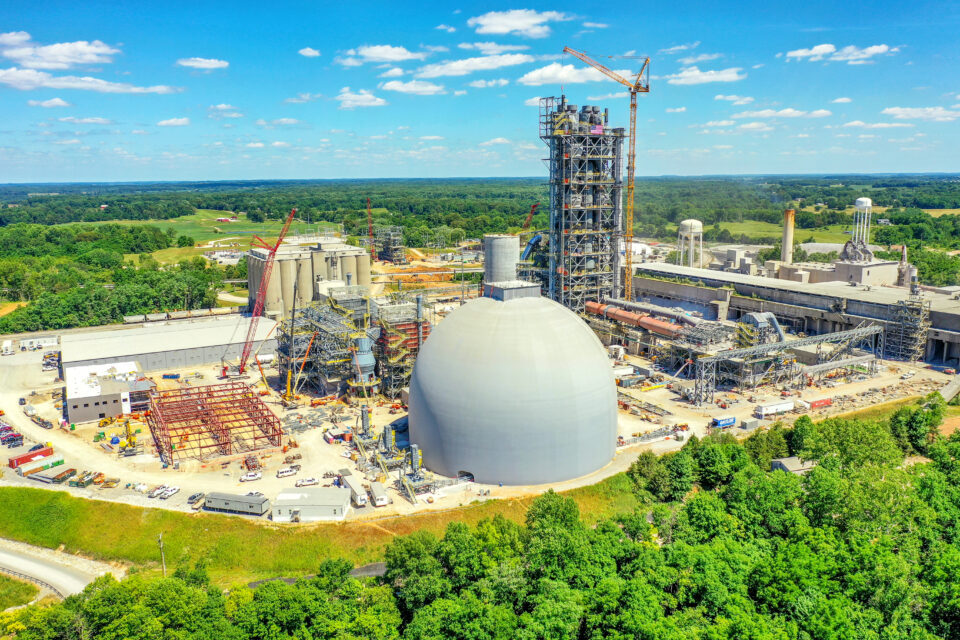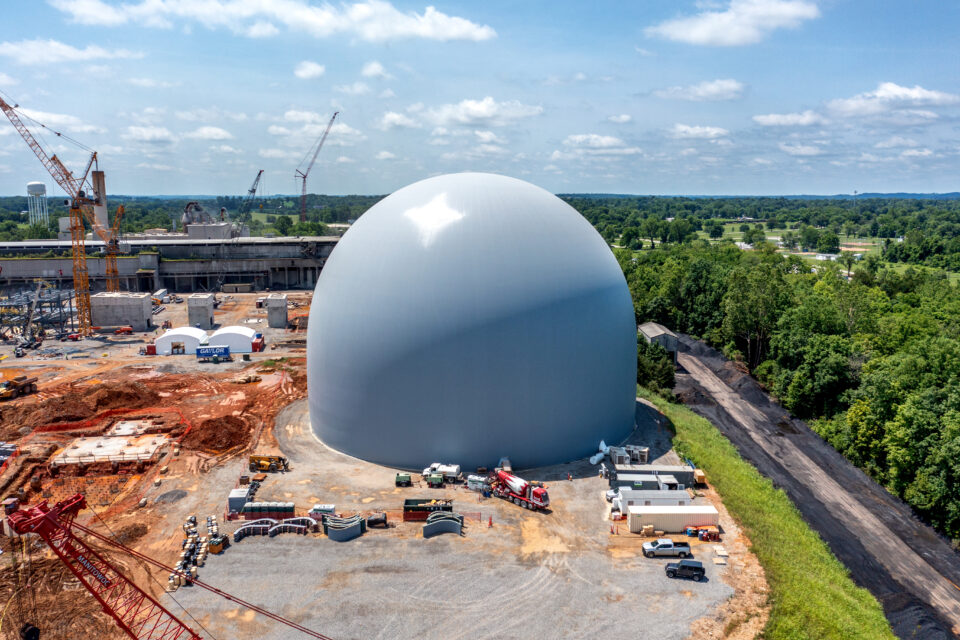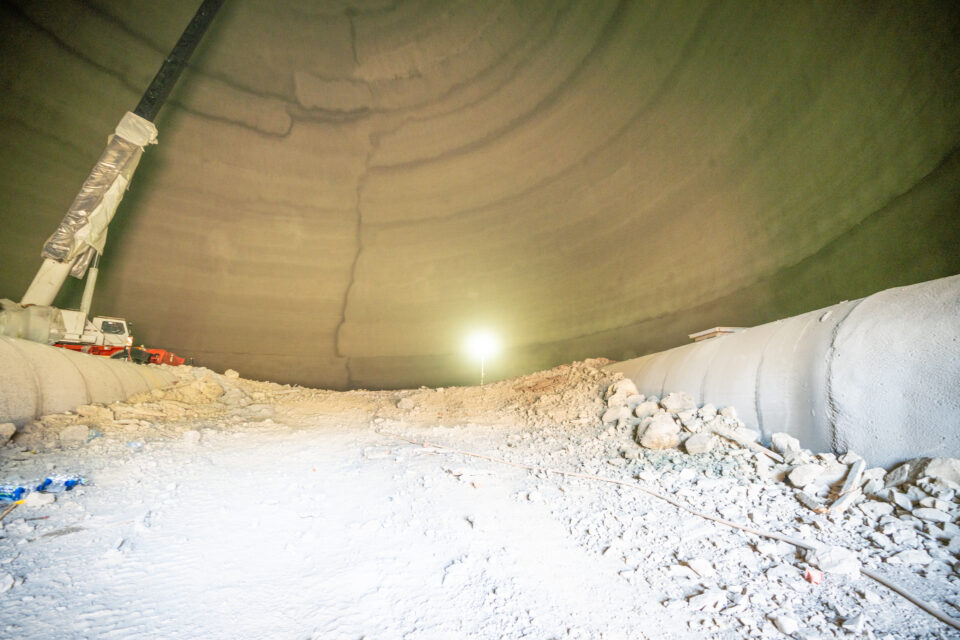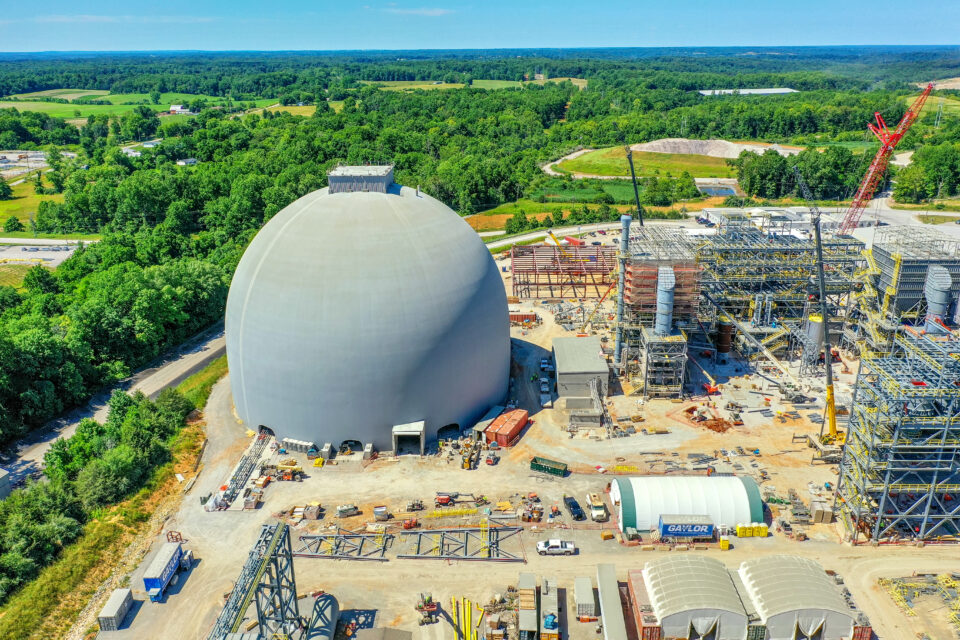Lehigh Cement Company contracted with Dome Technology to build a clinker-storage dome in Mitchell, Indiana, USA, one that will increase operational capacity and take the company into the next decade of business.
It’s also the largest clinker storage in the Western Hemisphere and second in the world only to a Romanian structure Dome Technology built in 2008.
This dome for Lehigh Cement, a subsidiary of Lehigh Hanson, dwarfs most other bulk storage, standing 220 feet in diameter and 160 feet tall. Its storage capacity maxes out at 169,000 metric tons, and three on-grade reclaim tunnels achieve 83 percent live reclaim.
“It’s a colossal project. It’s one of our bigger domes as far as storage capacity,” said Dome Technology sales manager Lane Roberts.
The project was centered around the second largest kiln in the Americas — an accurate representation of Lehigh’s “strong growth in the United States and our continued commitment to our customers to meet the growing demand for a consistent, high-quality cement whilst improving our manufacturing efficiencies and reducing emissions,” said Lehigh Cement deputy project director and civil manager Kevin Cove.
Dome Technology’s scope of work included dome construction, deep foundations, ring beam, tunnels and at-grade entry for front-end loader. While the dome size and sophistication are impressive, they simply represent a big goal for Lehigh: reducing environmental impact.

A green approach to business
The Mitchell project was part of Lehigh Cement’s efforts to upgrade an existing site 1.2 miles from the quarry, a proactive effort to reduce the facility’s impact on the environment. Lehigh Hanson has pinpointed sustainability as a corporate value, and its strategy for achieving it is based on three pillars: environmental protection, social responsibility and good corporate governance.
That’s the macro view, and success lies in the details. According to Cove, the Mitchell dome is large enough to replace work currently provided by five existing — and aging — kilns and will reduce overall emissions to meet and exceed current EPA standards. “The clinker dome allows the clinker to be completely contained, vastly reducing particulate emissions or dust. Lehigh Hanson’s long-term success depends on sustainable business practices as well as trusting relations with our neighbors, business partners and employees,” he said.
Also, Lehigh has developed EcoCemPLC, a Portland limestone cement that meets ASTM C595 Type IL standards with more limestone, less clinker and fewer CO2 emissions during production. It’s a new product that will be made and stored at the Mitchell plant, and to prove just how effective it can be, Lehigh requested that the dome be built with it.
Dome Technology put the material through considerable field testing prior to construction, and once confident, the crew sprayed 7,000 cubic yards to form the dome. Application was seamless, and ECOCemPLC will be the material of choice for Lehigh’s future. “We wanted all of our new construction to use it to showcase its capabilities, including specialty applications such as shotcrete that was used for the dome,” Cove said.
Even while under construction, the project drew public attention. Indiana Ready Mixed Concrete Association recognized the Mitchell dome with an outstanding concrete award, and ENR Technology featured the project, highlighting its concrete makeup that reduces energy and emissions for a reduced concrete-carbon footprint.

Large dome storage: A new model for Lehigh
Lehigh leadership had precision on their minds when planning the project. They knew all their new clinker would be channeled through this single dome, so the structural and mechanical concepts had to be robust. More specifically, the total settlement had to be limited to less than 75 mm, and live storage capacity must be a minimum of 140,000 metric tons.
A dome was a natural fit for these requirements. A dome is built with an unlimited lifespan, and its concrete shell and geometry boast unrivaled strength. Dome construction methods require no interior trusses, so the entire inside volume can be utilized for storage or reclaim systems.
All domes offer ideal conditions for stored materials requiring a controlled environment. Seamless concrete construction, coupled with a membrane surrounding the entire dome, prevents water and moisture entrance. The dome’s insulated nature reduces heating and cooling of the walls and air inside, preventing condensation. Foam and concrete control humidity and moderate externally generated temperature fluctuations.
A dome’s strength and geometry also provide a tolerance for differential settlement. Those qualities combined with geotechnical engineering and site analysis ensure proper foundation selection and performance.
Lehigh’s list of musts required focused and frequent conversation with the Dome Technology team. “Large storage domes are relatively new to Lehigh Hanson, so we required a high level of transparency with the design and construction techniques,” Cove said. “To ensure that we minimized issues with our feeding and withdrawal equipment, we needed to understand the total and differential settlements and balance the risks with cost.”
According to Cove, Dome Technology suggested multiple options based upon finite element modelling “that allowed us to find a cost-effective solution that would fit within our equipment vendor tolerances.”

Systems and solutions
Lehigh Cement has operated the Mitchell site for years, but upgrading storage was tricky because a water-table issue prevented tunnels from being placed underground. However, tunnels built at grade would reduce capacity. So Dome Technology suggested a new idea: Three tunnels could be installed on grade, then surrounded by structural backfill to within one foot of the top of the tunnels. The top foot was then layered with clinker, and this layer functions as the dome “floor.” With the dome filled, the company could expect 83 percent live reclaim through 10 drawdown hoppers to the three tunnels, and any clinker that remained between the troughs would serve as product reserve. Lehigh approved this option because it met the capacity requirement for 169,000 metric tons and 140,000 live metric tons, plus a reserve of 29,000 tons.
Once operations begin, clinker will be reclaimed from the dome to the three tunnels that are elliptical in shape — 15 feet wide and 9 feet tall. From there it will be conveyed for processing as cement powder, then stored in existing concrete silos. The finished cement will be trucked or railed to customers.

Collaboration to solve problems
Another challenge Dome Technology faced was achieving the necessary capacity while dealing with a conveyor angle that could not change. Engineers determined the maximum angle for optimal conveyor performance, and fitting the dome within this configuration would not deliver the capacity Lehigh needed.
Bumping up the dome’s diameter was the obvious, but unacceptable, solution. “We could have made the footprint larger, but that would have increased the cost substantially,” Roberts said.
Instead, Dome Technology looked up — right to the top of the dome. The opening at the apex was increased in size, and its curb was made taller, stretching from the standard two feet to 10 feet tall. This will allow the pile to extend into the headhouse, maximizing interior space and saving Lehigh some serious money. Clinker “can peak up into the height of the curb, which allowed them to achieve the tonnage,” Roberts said. “This was important so we could get the angle of the conveyor that was needed but still achieve tonnage.”
Soon the dome will be filled for the first time, and Lehigh Cement will begin to realize all the benefits this site was designed to provide.
“Dome Technology has performed exactly as described, living up to their commitments and executing exactly as planned. All aspects have involved open and honest communications. We are completely satisfied with the construction to date and have already hired Dome Technology for another Lehigh Hanson project,” Cove said.
Editor’s note: This article ran in the September BMHR issue of World Cement.